Gentleman, the Good Lord put some invisible “good mojos” inside of the burl of the heather shrubs that grew around the rim of the Mediterranean. He put the most good mojos inside old Algerian burls, but they all have a good dose of the goodie.
To be usable a burl has to be soaked or boiled or steamed to remove as many bad mojos as possible and when we smoke the briar we keep up the good work of driving out the bad mojos. That’s why briar pipes get better, with use, but only to a point, then they go backwards.
In the late thirties KB&B sold $3.50, $5, and $10 Kaywoodie pipes and $1, $1.50, and $2.50 Yello Bole pipes.
The pipe on the bottom was a top grade $2.50 Yello Bole about 80 years ago. The pipe on top is a $10 Algerian briar factory pipe that is brand new, from some old stash of Revolutionary Algerian government factory about fifty or sixty years ago.
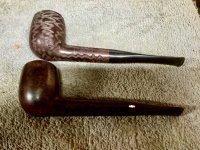
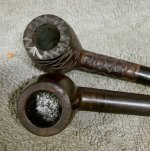
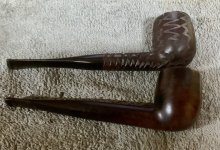
The Yello Bole just missed being shipped as a $10 Flame Grain. It’s turned black but if I hold it to the light there is spectacular grain under the black.
I have given the Yello Bole at least five salt and everclear treatments and each time the salt got cleaner and whiter until I’ve got all the tars out that are coming out.
Then I gave it several more cotton ball and vodka (60% water in vodka) to dissolve any salt left inside.
I’ve scrubbed it using toothpaste until it’s as brown as it will ever be.
The thing is just plain worn out. All the good mojos have been smoked out and won’t ever come back.
Now, my worn out Yello Bole Imperial is not a bad, nasty smoker. If it was your only pipe you’d like it.
It’s as bland as unsweetened oatmeal. It mutes every tobacco I try in it.
My El Morjane Algerian billiard was the world’s crudest pipe. But if you don’t belive in good mojos you’ve never smoked a fresh Algerian with the same tobacco as a worn out briar pipe.
Algerian briar only smokes a little better than any other briar that still has good mojos.
In this case it’s off the charts better.
The best place to keep a worn out pipe is where you can find it to remind yourself there are so many good smokes a pipe has, and not one more.
Even this fresh machine turned and unfinished $5 no name briar smokes head and shoulders better than a worn out briar pipe.
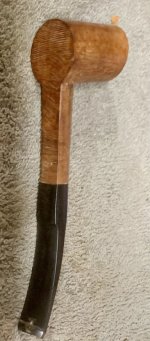
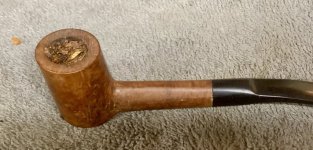
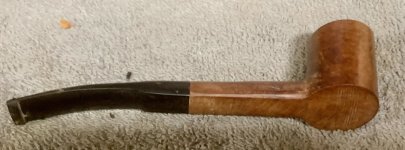
Good mojos inside all briar, provide a zest and zing and whang to a smoke until they are just, all used up.
To be usable a burl has to be soaked or boiled or steamed to remove as many bad mojos as possible and when we smoke the briar we keep up the good work of driving out the bad mojos. That’s why briar pipes get better, with use, but only to a point, then they go backwards.
In the late thirties KB&B sold $3.50, $5, and $10 Kaywoodie pipes and $1, $1.50, and $2.50 Yello Bole pipes.
The pipe on the bottom was a top grade $2.50 Yello Bole about 80 years ago. The pipe on top is a $10 Algerian briar factory pipe that is brand new, from some old stash of Revolutionary Algerian government factory about fifty or sixty years ago.



The Yello Bole just missed being shipped as a $10 Flame Grain. It’s turned black but if I hold it to the light there is spectacular grain under the black.
I have given the Yello Bole at least five salt and everclear treatments and each time the salt got cleaner and whiter until I’ve got all the tars out that are coming out.
Then I gave it several more cotton ball and vodka (60% water in vodka) to dissolve any salt left inside.
I’ve scrubbed it using toothpaste until it’s as brown as it will ever be.
The thing is just plain worn out. All the good mojos have been smoked out and won’t ever come back.
Now, my worn out Yello Bole Imperial is not a bad, nasty smoker. If it was your only pipe you’d like it.
It’s as bland as unsweetened oatmeal. It mutes every tobacco I try in it.
My El Morjane Algerian billiard was the world’s crudest pipe. But if you don’t belive in good mojos you’ve never smoked a fresh Algerian with the same tobacco as a worn out briar pipe.
Algerian briar only smokes a little better than any other briar that still has good mojos.
In this case it’s off the charts better.
The best place to keep a worn out pipe is where you can find it to remind yourself there are so many good smokes a pipe has, and not one more.
Even this fresh machine turned and unfinished $5 no name briar smokes head and shoulders better than a worn out briar pipe.



Good mojos inside all briar, provide a zest and zing and whang to a smoke until they are just, all used up.
Last edited:






